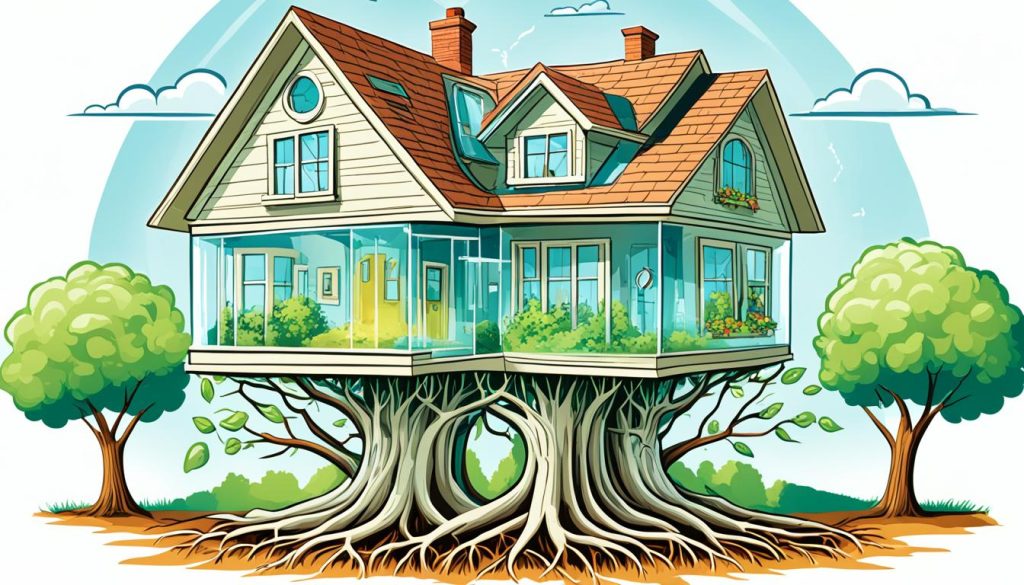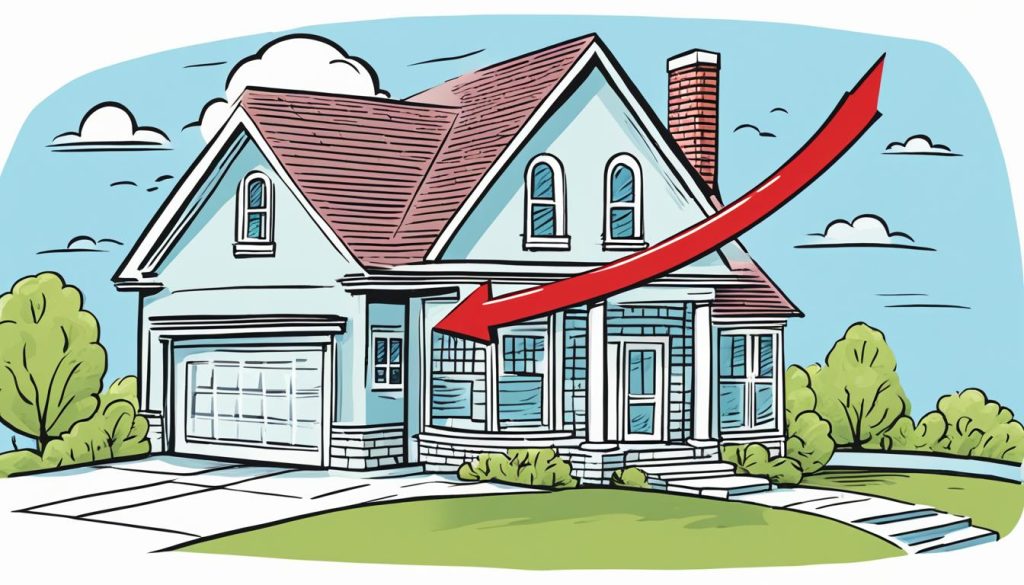Some homeowners use a1 home equity loan or a home equity line of credit (HELOC) for big expenses. Home equity is the value of your home minus what you owe on loans like a mortgage. You can build equity by paying a down payment and making mortgage payments over time.
Improvements, repairs, and rising property values can also increase your home equity.
Key Takeaways
- Home equity loans and HELOCs let homeowners borrow against their home’s equity.
- Home equity loans have fixed interest rates and terms from 5 to 15 years.
- HELOCs offer flexibility with a 10-year draw period and interest-only payments on what you borrow.
- Lenders look at your home equity, credit score, and debt-to-income ratio for approval.
- Knowing the pros and cons of each option helps you pick the best home equity financing for you.
What are Home Equity Loans and HELOCs?
There are two main ways to use your home’s equity: home equity loans and home equity lines of credit (HELOCs). Both let you borrow against your home’s value. But, they work and are structured differently.
Home Equity Loans
A home equity loan gives you a lump sum of cash, backed by your home’s equity. These loans have fixed interest rates and repayment times from 5 to 15 years2. You can borrow up to 85% of your home’s value, minus any mortgage balance2.
Home Equity Lines of Credit (HELOCs)
A home equity line of credit (HELOC) is a revolving line of credit, also backed by your home’s equity. It lets you borrow money as you need it, up to a set limit. HELOCs have an initial “draw period” for accessing funds, followed by a repayment period2. Their interest rates are variable, offering flexibility but unpredictable monthly payments compared to fixed-rate loans.
Both home equity loans and HELOCs let you tap up to 85% of your home’s equity2. They’re popular for financing home improvements, paying off debt, or other financial needs. Knowing the differences between these options can help you pick the best one for your situation.
How Home Equity Loans and HELOCs Work
If you own a home, you might be able to borrow against its equity. You can do this through a home equity loan or a home equity line of credit (HELOC). These loans use your home as security, letting you tap into your property’s value. But, they differ in how you get and pay back the money.
A home equity loan gives you a big sum of cash all at once. You then pay it back over a set time, usually with a fixed interest rate3. A HELOC, however, lets you borrow money as you need it during a 10-year draw period3. After that, you have 20 years to pay it back3.
Lenders let you borrow up to 85% of your home’s value minus your mortgage balance for a HELOC3. Bank of America even lets you switch part of your HELOC to a fixed rate3. They also don’t charge application, annual, or closing fees, but there’s a fee if you close the account early in the first 36 months3.
HELOCs usually have lower interest rates than other credit types3. The interest might be tax-deductible, but check with a tax advisor3. Home equity loans have a fixed rate and the interest might be deductible if used for home improvements4.
Choosing between home equity loans and HELOCs means understanding they both use your home as collateral. If you can’t pay, the lender can take your property3. Lenders look at your credit, income, and debt-to-income ratio to decide if you qualify and what terms you’ll get4.
Home equity loans and HELOCs can be great for those who know the risks and benefits. Think about your needs and finances to pick the best option for your goals.
home equity loan, HELOC, borrowing against home equity
When you want to use your home’s equity, you can choose between a home equity loan (HEL) or a home equity line of credit (HELOC). Each has its own benefits, and the right choice depends on your financial needs and goals5.
A home equity loan gives you a lump sum with a fixed interest rate. It’s great for one-time expenses like home improvements or paying off debt. Lenders usually allow an LTV of 70% to 90%, based on your location and credit score5. For instance, if your home is worth $350,000 and you borrow $200,000, your LTV is 57.1%5.
A HELOC lets you access funds as needed, making it good for ongoing expenses. It’s useful if you have several financial needs. Lenders might let you borrow up to 85% of your home’s value for a second loan5. But, having both a HEL and a HELOC might increase the interest rate on the second one5.
Interest rates for HELs and HELOCs vary based on the lender, your location, the loan amount, your credit score, and more5. HELs usually have fixed rates, while HELOCs have rates that can change with the market5.
Homeowners with a lot of equity might refinance their debt for better terms5. Some lenders also make it easier to get approved if you already have a home equity product with them5.
You can have several HELs and HELOCs on different properties, depending on the lender’s rules5. As of December 2023, U.S. homeowners have $10.3 trillion in home equity, with $8.24 trillion considered “tappable”6. This shows the huge potential for homeowners to use their home’s value for financial goals.

Think about your needs, spending, and financial goals when deciding between a HEL and a HELOC. Knowing the details of home equity financing can help you make a choice that fits your situation7.
Advantages and Disadvantages
Home equity loans and HELOCs can be great financial tools. They offer both good and bad points for borrowers. It’s key to know these pros and cons before deciding if home equity financing fits your needs.
Advantages
One big plus of home equity loans and HELOCs is often lower interest rates than other loans8. Plus, the interest you pay might be tax-deductible if it’s for home improvements8. These loans also let you use the money for many things, like fixing up your home, covering emergencies, or paying off debt9.
Disadvantages
But, home equity financing has its downsides. HELOCs have variable interest rates that can go up or down, making your payments unpredictable8. These loans use your home as collateral, so not paying them back could lead to losing your home8. Taking on too much debt during the draw period can make payments hard to manage when it’s time to repay8. Also, you might face penalties for paying off the loan early, adding to the cost8.
It’s important to think about the good and bad of home equity loans and HELOCs before deciding if they’re right for you9. Talking to financial experts can help you make a smart choice and understand the full impact of home equity financing9.

Qualifying for Home Equity Financing
To get a home equity loan or a HELOC, you must meet certain lender requirements. You need to show you have enough equity in your home, have a good credit history, and a steady income10.
Lenders usually want at least 20% equity in your home, but some accept 15%10. Your credit score is key, needing to be in the mid-600s or higher11. They also check your debt-to-income (DTI) ratio, aiming for 43% or less1011.
Having a stable income is important to show you can make regular payments10. The process might include a home appraisal to figure out your property’s value. This helps calculate the CLTV ratio1011.
When applying for a home equity loan or HELOC, be ready with your documents. You’ll need tax returns, pay stubs, and details about your current mortgage and debts. Lenders use this info to see if you qualify and how much you can borrow1011.
Understanding what you need for home equity financing and improving your finances can boost your chances of getting the funding you want1011.
Conclusion
Home equity loans and HELOCs are great for homeowners looking for funds. The12 Flex Home Equity Line of Credit (HELOC) offers an APR as low as 8.279%, with a max of 18.00%. It also allows borrowing up to 80% of your home’s value12. The Fixed-rate, Fixed-term Home Equity Loan has an APR as low as 6.24%, with terms up to 5 or 10 years12. You can borrow up to 90% of your home’s value, minus the first mortgage balance12.
But, it’s important to think carefully before getting home equity financing13. HELOCs give you a line of credit based on your home’s equity, with low variable rates and flexible payments13. Home Equity Loans give you a lump sum, based on your home’s value, with fixed rates and payments13. You can usually borrow up to 80% of your home’s equity with these options13.
Knowing the differences between these options and your finances helps you decide if home equity financing is right for you13. Home loans and credit lines need credit and collateral approval and may not be available everywhere13.
FAQ
What is a home equity loan?
A home equity loan lets you borrow money against your home’s equity. You get a lump sum with fixed interest rates and repayment terms of 5, 10, or 15 years.
What is a home equity line of credit (HELOC)?
A HELOC is like a credit card but uses your home as collateral. You can borrow money as needed up to a set limit. The interest rates change, and you have an initial draw period followed by a repayment period.
How do home equity loans and HELOCs work?
Home equity loans give you a big sum of money upfront. HELOCs let you take money as you need it during a draw period. Both use your home as collateral, so the lender can take your property if you don’t pay back the loan.
What can home equity loans and HELOCs be used for?
You can use home equity financing for things like fixing up your home, paying off debt, or covering big expenses. Choose a loan for a one-time sum or a HELOC for ongoing cash needs.
What are the advantages and disadvantages of home equity loans and HELOCs?
These loans have lower interest rates and might let you deduct the interest on taxes. They also offer flexibility in how you use the money. But, they come with risks like losing your home if you can’t pay back the loan, and your home’s value could drop, leaving you owing more than your home is worth.
What are the requirements to qualify for a home equity loan or HELOC?
You need enough equity in your home, a solid credit history, and steady income. Lenders look for at least 15-20% equity and check your debt-to-income ratio and credit scores.
Source Links
- Articles
- HELOC vs. Home Equity Loan | LendingTree
- What is a Home Equity Line of Credit and How Does it Work?
- How a Home Equity Loan Works, Rates, Requirements & Calculator
- Can You Have a Home Equity Loan and Line of Credit? | LendEDU
- Home Equity: What Is It And How Can You Use It? | Bankrate
- Heloc vs Home Equity Loan: When Are They a Good Idea?
- Pros And Cons Of Home Equity Line Of Credit (HELOC) | Bankrate
- The Pros and Cons of a Home Equity Line of Credit (HELOC)
- HELOC And Home Equity Loan Requirements In 2024 | Bankrate
- Home equity loan requirements: What you need to know
- Home Equity Loan & Home Equity Line Of Credit (HELOC)
- Home Equity Loans and HELOC Comparison | KeyBank

